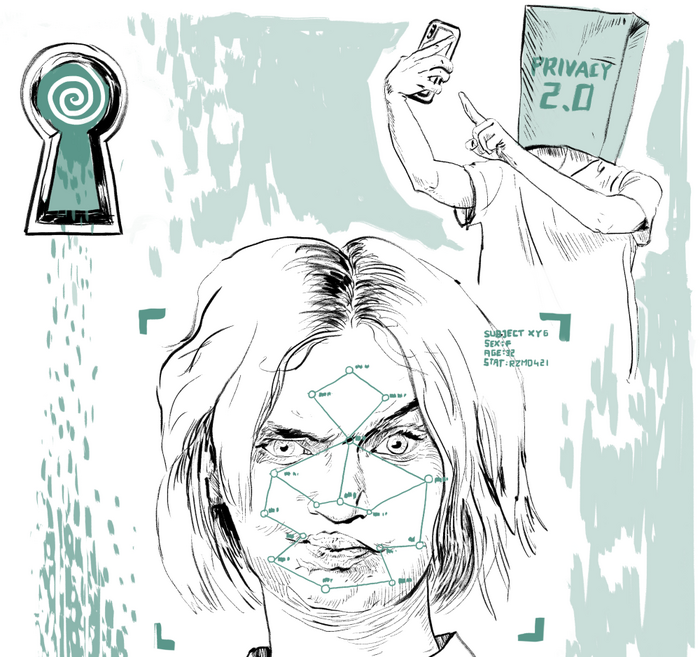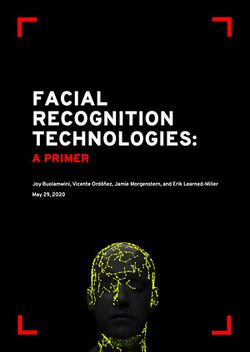In a democratic society identification/being visible and anonymity/privacy are both constituent elements of social participation. Especially biometric technology tackles these dimensions. Many security measures, anti-terror measures, predictive policing, space monitoring and access technologies build on a compendium of datafied services. Facial recognition or other biometrics might serve to increase safety and support security, for instance in the sense that no unauthorized person has access to a space or sensitive data, thanks to biometric recognition in banking apps or smartphones. On the other hand, such services open a window to surveillance and abuse. With abusive biometric technology in public spaces, civil and peaceful protests in more and more states are undermined, or groups are excluded from access by machines, for instance at entry gates to public spaces. The technology is also a thread for privacy on a larger scale. The startup Clear-View AI provoked a huge scandal because they connected three billion pictures of people from many publicly available databases with a biometric algorithm and offered their customers to identify a person on a picture taken in passing. Their customers were mainly public authorities with different democratic reputations but the database was also used for private stalking.
The EU sees in Biometric Technology a particular risk and has declared the need for specific awareness to its limitation and control. The European Data Protection Board and the European Data Protection Supervisor even call for a “ban on use of AI for automated recognition of human features in publicly accessible spaces” (European Data Protection Board, 2021).
Contents
Biometry: Definition
Technology using, according to the GDPR, “personal data resulting from specific processing relating to the physical, physiological or behavioural characteristics of a natural person, which allow or confirm unique identification of that natural person” (Article 4 (14) EU GDPR).
- When you read this broad definition, reflect on what kind of biometric technology you use (voluntarily)?
- Where have you been exposed to biometric technology, for instance in public spaces?
- What kind of biometric data of yours is available on the Internet or in databases?
- What is your experience with biometric technology?
Video: Evidence - Biometric mass surveillance in the EU
Source: EDRi - European Digital Rights
Resource: Facial recognition technologies: a primer
The primer is written for a non-technical audience to increase understanding of the terminology, applications, and difficulties of evaluating the complex set of facial recognition technologies
- Buolamwini, J; Ordóñez, V; Morgenstern, J.; Learned-Miller, E. (2020). Facial recognition technologies: A primer. Algorithmic Justice League, MacArthur Foundation.
References
- European Data Portection Board (2021). EDPB & EDPS call for ban on use of AI for automated recognition of human features in publicly accessible spaces, and some other uses of AI that can lead to unfair discrimination, 21 June, 21.
- European Data Protection Regulation: https://gdpr.eu/tag/gdpr/
- Buolamwini, J; Ordóñez, V; Morgenstern, J.; Learned-Miller, E. (2020). Facial recognition technologies: A primer. Algorithmic Justice League, MacArthur Foundation.
- Illustration: Felix Kumpfe/Atelier Hurra
Nils-Eyk Zimmermann
Editor of Competendo. He writes and works on the topics: active citizenship, civil society, digital transformation, non-formal and lifelong learning, capacity building. Coordinator of European projects, in example DIGIT-AL Digital Transformation in Adult Learning for Active Citizenship, DARE network.
Blogs here: Blog: Civil Resilience.
Email: nils.zimmermann@dare-network.eu
handbook for Facilitators: Learning the Digital
This text was published in: M. Oberosler (ed.), E. Rapetti (ed.), N. Zimmermann (ed.), G. Pirker, I. Carvalho, G. Briz, V. Vivona (2021/22). Learning the Digital. Competendo Handbook for Facilitators.
Created in the frame of the project DIGIT-AL - Digital Transformation Adult Learning for Active Citizenship.











